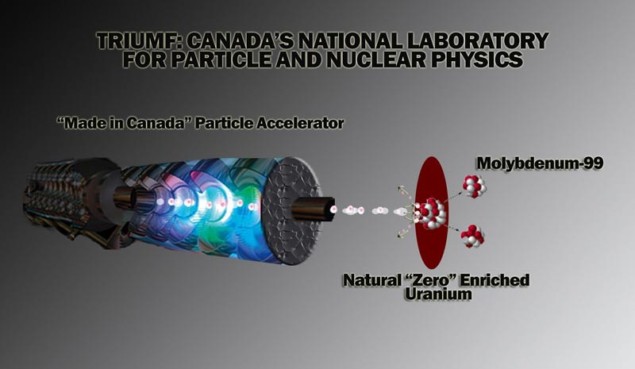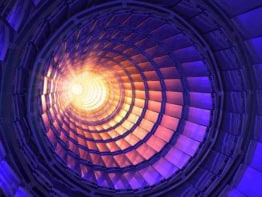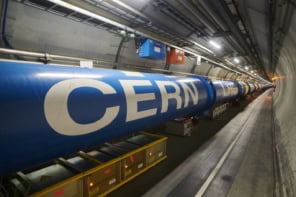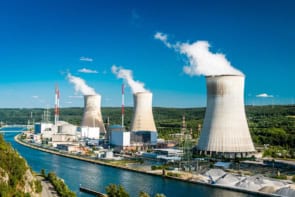
The TRIUMF nuclear and particle physics laboratory in British Columbia is to build an extremely intense electron linear accelerator in order to produce radioactive isotopes for fundamental research and medicine. In particular, it is hoped that the C$63m ARIEL facility, which got the go-ahead last week, will help secure supplies of the vital medical isotope technetium-99m.
Short-lived technetium-99m is used in about 80% of all nuclear-based medical diagnoses, generating gamma rays that can be used to pinpoint disease when the isotope is bound into special molecules and then ingested or injected. It is produced by the decay of molybdenum-99, which is currently exclusively manufactured in a handful of nuclear reactors worldwide via the neutron-induced fission of enriched uranium-235. Unfortunately these reactors are ageing and unreliable. For example, Canada’s NRU facility in Ontario normally supplies about 30% of the world’s molybdenum-99, but has been out of action for about a year. Furthermore, the highly enriched uranium used in this process poses a weapons proliferation risk.
The ARIEL project forms part of the Canadian government’s plans to modernize isotope production. At the heart of the facility will be a superconducting linear accelerator capable of generating electron beams with energies of 50 megaelectronvolts (MeV) and currents of 10 mA. The beam will be fired along an underground tunnel, at the end of which it will be directed onto a convertor material, producing an intense photon beam via the process of bremsstrahlung. These photons will then go on to strike a target made of, for example beryllium or uranium, shattering the nuclei within the target and generating a range of isotopes. The radioisotopes of interest will then be separated out.
Avoids reactor complications
As TRIUMF director Nigel Lockyer points out, this accelerator-based production of radioisotopes avoids the complications involved in siting, operating and maintaining a nuclear reactor. In addition, he says, accelerators can be easily switched on and off. According to Lockyer, as well as generating molybdenum-99 and other isotopes that could be potentially used in medical diagnoses, ARIEL will be used to carry out a range of physics research. This could include the study of magnetic materials and the investigation of exotic isotopes of tin beyond Sn-132 in order to better understand how the shell structure within nuclei evolves and breaks down.
Jerry Nolen, a physicist at the Argonne National Laboratory in the US, welcomes TRIUMF’s linear accelerator project as “a great addition to the lab’s radioactive-beam basic research programme”, adding that the development of this technology is useful in its own right. However, while he believes that the “photofission” process could meet a small part of Canada’s demand for molybdenum-99, he does not think that it will be competitive at the global level. This, he says, is due to the very high beam power required, which results from the reaction’s far smaller cross-section compared to that of the neutron-induced fission of uranium-235. Nolen also believes that target development will be “a very significant challenge”, but one that the Canadian lab will overcome.
ARIEL got the green light this week with the announcement by the province of British Columbia that it is to contribute C$30.7m to the project. This funding follows previous commitments by the national government. Construction is due to begin next month, with completion set for 2013 and then accelerator commissioning a year later. Routine isotope production is due to start in 2015.



